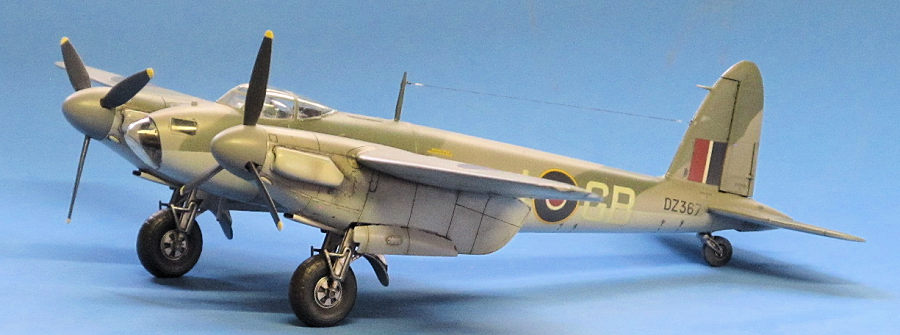
Tamiya 1/72 Mosquito B/PR.IV
| KIT #: | 60753 |
| PRICE: | $25.00 |
| DECALS: | Three options |
| REVIEWER: | Ryan Grosswiler |
| NOTES: | Rob Taurus Vac canopy. |

| HISTORY |
I can't think of a single WWII design which influenced modern air combat more than de Havilland's DH.98 Mosquito. Geoffrey de Havilland had already established a name for himself by 1917 with his DH.4, the first bombardment aircraft to offer something more in performance and maneuverability against the supposedly "chivalrous" Great War fighter pilots than the lumbering targets which had previously fattened their kill tallies. But his young firm took a stern hit, like many others, with the drawdown in business that the Armistice had brought. So...more effort in creativity would be required to weather the lean times of peace. An initial move into the airliner business was unsuccessful as Handley-Page was already bullying into dominance there; a second effort to win the market of the imagined "everyman's airplane" showed the designer what not to do in the form of the DH.53 Hummingbird. However, rethinking the idea created the DH.60 Gypsy Moth, then (with a new engine and wing sweep) the DH.82 Tiger Moth, which became the Empire's standard basic trainer. de Havilland's company survived with this success to return to its preferred experimentation in high-performance aircraft.
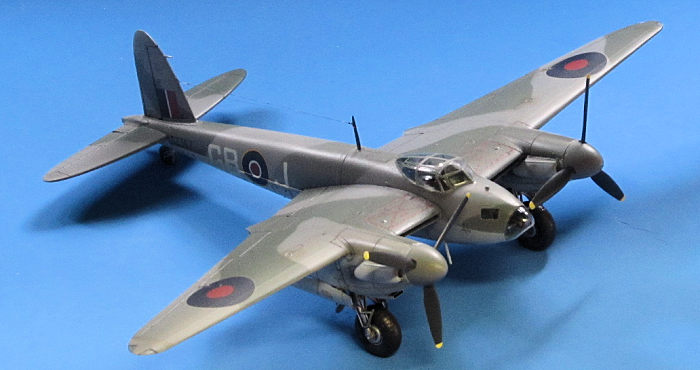 The record-breaking
DH. 88 Comet racer (designed and built in secrecy for three customers kept
otherwise in in the dark until rollout) was the first result. This led to the
DH.91 Albatross airliner. Increasing pressure on de
Havilland to devote more attention to military projects in the last years before
the Munich Crisis led to renewed interest in a unique concept: the fast, unarmed
bomber. This idea had been bandied about more than once and had always been
invalidated when fighter aircraft development would simply catch up in
performance to the fast bomber in a couple of years. What saved the Mosquito
here was the fact that where its maximum speed topped out—around 400
knots—happened to be the approximate absolute maximum for
all
piston-engine aircraft, which meant that the fighters of the time could only
ever really hope to match the Mosquito’s speed, not better it. It was also only
at this point that the Mosquito was available in sufficient numbers for
large-scale operations.
The record-breaking
DH. 88 Comet racer (designed and built in secrecy for three customers kept
otherwise in in the dark until rollout) was the first result. This led to the
DH.91 Albatross airliner. Increasing pressure on de
Havilland to devote more attention to military projects in the last years before
the Munich Crisis led to renewed interest in a unique concept: the fast, unarmed
bomber. This idea had been bandied about more than once and had always been
invalidated when fighter aircraft development would simply catch up in
performance to the fast bomber in a couple of years. What saved the Mosquito
here was the fact that where its maximum speed topped out—around 400
knots—happened to be the approximate absolute maximum for
all
piston-engine aircraft, which meant that the fighters of the time could only
ever really hope to match the Mosquito’s speed, not better it. It was also only
at this point that the Mosquito was available in sufficient numbers for
large-scale operations.
By then, of course, the Germans had developed and deployed the Ar-234 jet bomber. What the two aircraft shared was pioneering the 'strike fighter' concept of a fast bomber coming in fairly low to destroy a very specific, clearly defined target...and the multirole aircraft, one single base airframe to serve a variety of combat missions with only superficial modification and changes to equipment (there are limits to this, of course, as the Navy's F-111 fiasco and today's F-35 A/B/C have demonstrated, all of which have managed to reverse the intention of speeding up development time and savings on cost).
A lot of noise has been made over the past 75 years over the Mosquito's wooden structure, ostensibly to 'save on strategic materials' and be subcontracted to such enterprises as furniture manufacturers, another shrewd move in wartime. It was not, however, a technological throwback, as is frequently implied: in the seemingly retrograde move back to this organic material was actually another step forward towards monocoque composite structures formed into curves more complex and smooth than ever possible with the aluminum stressed skin of the time, picking up where the 1913 Deperdussin racer had started, the 1930s Lockheed airliners had left off, and pointing the way to the advanced composite aircraft structures at the far end of the century.
| THE KIT |
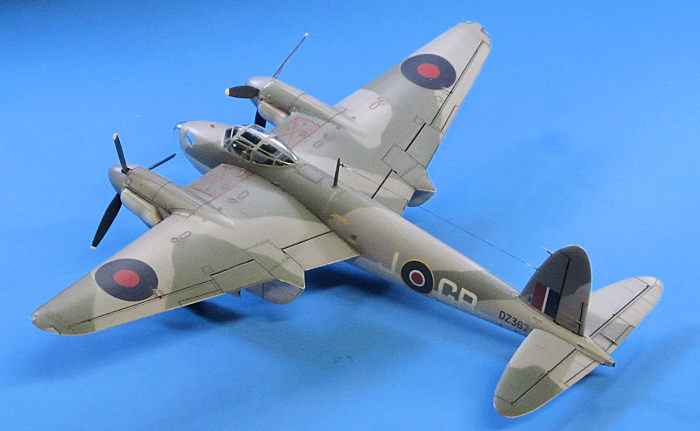 As one of the most
beloved WWII aircraft, the "Mossie" has always been well served in all the main
modeling scales. When Tamiya released this set of kits in the early 'aughts, it
pretty much made all the previous 1/72 offerings obsolete. Hasegawa came out
with its own competitor around the same time but modelers seem to prefer this
one.
As one of the most
beloved WWII aircraft, the "Mossie" has always been well served in all the main
modeling scales. When Tamiya released this set of kits in the early 'aughts, it
pretty much made all the previous 1/72 offerings obsolete. Hasegawa came out
with its own competitor around the same time but modelers seem to prefer this
one.
You can predict what's in this Tamiya box: several sprues in medium gray, one in clear. A good set of decals covering three schemes and (unusually for Tamiya) a fair number of unused parts hinting at further variants, including a pair of slipper tanks and paddle-bladed props. A succinct and clear set of instructions detailing not only the general construction sequence but detail differences between the marking options along the way. Everything is bagged with intelligent separation to ensure safe transit into your hands. Quality on all parts is state of the art for the industry. Other than the discouraging photographic box art the whole package just screams, "BUILD ME!!!"
It seemed that everyone at the time of its release was building this kit, but in all scales the gun-nose FB Mk. VI has always been the most popular selection. In contrast, I consider glass-nosed B/PR Mk. IV to be far and away the best-looking version of the Mosquito, so I thought that this particular release would be a good subject for a retrospective.
| CONSTRUCTION |
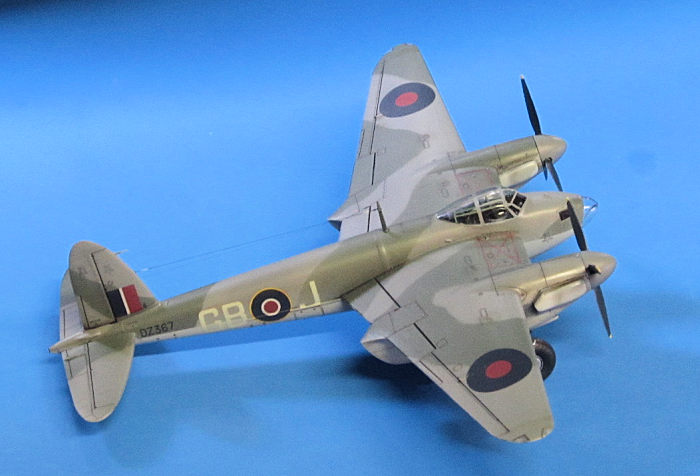 Totally easy; you
really would have to make a conscious effort to screw this one up. This dude
managed to do so, however, not in construction
but in the finishing stage when he got overconfident with a new airbrush and
tried to freehand the whole scheme. The result looked really stupid, so the
model was stripped with oven cleaner and tossed back in the box. Life then got
super complicated and
the project was forgotten for the next 15 years, until just a few weekends ago
it was rediscovered through some long overdue attic-junk processing.
Totally easy; you
really would have to make a conscious effort to screw this one up. This dude
managed to do so, however, not in construction
but in the finishing stage when he got overconfident with a new airbrush and
tried to freehand the whole scheme. The result looked really stupid, so the
model was stripped with oven cleaner and tossed back in the box. Life then got
super complicated and
the project was forgotten for the next 15 years, until just a few weekends ago
it was rediscovered through some long overdue attic-junk processing.
I resumed work after this long pause by popping off the injection-molded canopies and replacing them with some fresh vacuformed ones by Rob Taurus. These not only look more refined than the stock parts but allow the modeler to depict the original's internal aft framing correctly, however one wants to do this. As a bonus, the Eduard canopy masking set fits these aftermarket parts perfectly.
There's plenty of interior detail for the scale, but the truly fastidious will want to sheet over the open radio backs and maybe add a little wiring and framing detail around the radio deck. Also, there's a prominent alignment-pin abutment on the ceiling of the bombardier's compartment. If you don't grind this away and are the sort which likes peering in at cockpit interiors of completed models this protrusion will totally annoy you.
Tamiya's researchers reportedly crawled all over the examples at the Mosquito Museum for several days to document the project; the dimensions and contours are all as result as close to perfect as it gets. Online chatter has it that the one exception is the vertical tail being 2mm too tall, something that my drawings seemed to confirm. I photocopied one of them, cut out the tail and used it as a template to sand and recontour the part to the marginally shorter dimension. This isn't because I felt the model really needed it, but that I really enjoy this kind of work.
The main wheel well rear bulkhead has a big seam running down the middle. This surface was sheeted over with styrene and a few details added from bits of .020 rod and strip following photos pulled from the interweb, as the photographers for the Squadron Walk-Around book missed this bit. Doesn't seem like much, but the twenty minutes' work here enhanced the appearance of this nether-region greatly.
Carburetor
intakes beneath and behind the propeller spinners are molded 'solid', i.e. no
intake opening. This is my only note of the kit plastic actually falling short
of the mark. Using a .7mm bit spun in my fingers, I drilled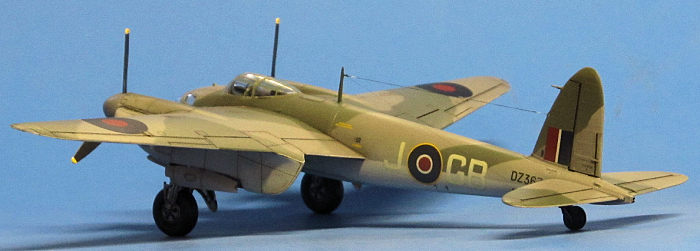 a hole at each end of each intake, then linked the two with more holes drilled
in between, and finished by carefully augering and smoothing down the intake
walls with the same drill bit.
A bit of liquid cement was then brushed over to smooth it all out. All this was
under intense light and magnification. Eduard has an inexpensive photoetched set
for the Mk. VI which includes a set of the mesh filters which were fitted here
on most aircraft: I'll be using this set on my next go at the kit. The bonus is
that Eduard’s set also has a pair of parts to graft over the kit's lame radiator
grilles.
a hole at each end of each intake, then linked the two with more holes drilled
in between, and finished by carefully augering and smoothing down the intake
walls with the same drill bit.
A bit of liquid cement was then brushed over to smooth it all out. All this was
under intense light and magnification. Eduard has an inexpensive photoetched set
for the Mk. VI which includes a set of the mesh filters which were fitted here
on most aircraft: I'll be using this set on my next go at the kit. The bonus is
that Eduard’s set also has a pair of parts to graft over the kit's lame radiator
grilles.
One final word of warning: on my sample, the prop shafts 'grabbed' the poly cap in the prop hub very, very hard. This might seem like a non-issue, but during one of the fit checks during assembly the problem led me to actually wrench off one of them, not only breaking the part but trapping the shaft in the prop hub. Avoid this potential heart-stopper by taking five minutes to sand down the diameter/circumference of both shafts slightly to reduce the friction. I was able to recover by carefully drilling a hole centered in the trapped shaft, threading a tiny screw into it, and pulling it out with pliers. The shaft was then re-glued into a new hole in the cowl face—and sanded down!
| COLORS & MARKINGS |
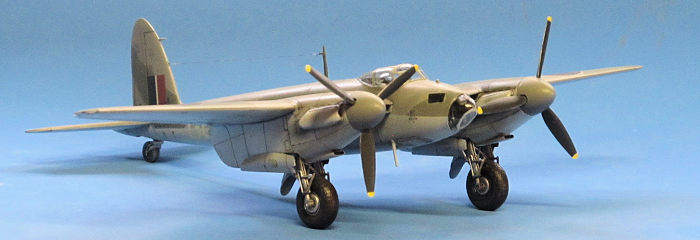 The
canopies were masked and a little interior color sprayed to color the frame
interiors. This was followed by my new favored first coat: Tamiya white primer
decanted out of its rattle can, given an hour to out-gas, and cut about 50/50
with Randolph butyrate dope thinner. The Medium Sea Grey/Ocean Grey/Dark Green
colors were then sprayed on with enamels, this time properly and patiently
masked.
The
canopies were masked and a little interior color sprayed to color the frame
interiors. This was followed by my new favored first coat: Tamiya white primer
decanted out of its rattle can, given an hour to out-gas, and cut about 50/50
with Randolph butyrate dope thinner. The Medium Sea Grey/Ocean Grey/Dark Green
colors were then sprayed on with enamels, this time properly and patiently
masked.
A couple barrier coats of Gunze gloss provided the smooth surface for the decals—these are nicely printed but rather thick, so much so that I never quite got rid of the carrier film ridge even after several gloss coats and wet-sanding between. A light weathering of pastels and oil followed, all this being sealed up with a semi-gloss final coat. The landing gear, gear doors, and antennas went on and that was it.
| CONCLUSIONS |
Looks much better this time around! Tamiya's Mosquitos are at this writing still a super good value even in today's stupendously skyrocketing cost of living. If you want to model a late aircraft with the two-stage blower resin aftermarket modification sets are still available.
The lazily-depicted carburetor intakes are my sole complaint about the kit. This is otherwise a superb build, suitable for all comers. Twenty years on, it's still the best kit, though New Airfix has stepped into the ring with a set of later marks that apparently better Tamiya's in detail but not in refinement.
| REFERENCES |
MacKay, Ron. Mosquito Walk Around. Squadron-Signal, 1998. ISBN 0-89747-396-5
Scutts, Jerry. Mosquito In Action. Squadron-Signal, 1992. ISBN 0-89747-283-7
Various Draftsmen. Aircraft Archive: Fighters of World War Two Vol. 2 Motorbooks Int’l.
18 April 2024
Copyright ModelingMadness.com. All rights reserved. No reproduction in part or in whole without express permission from the editor.
If you would like your product reviewed fairly and fairly quickly, please contact the editor or see other details in the Note to Contributors.